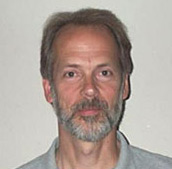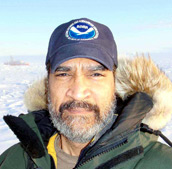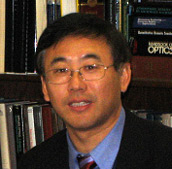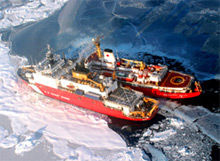Four STAR Scientists Receive 2009 Administrator's Awards
28 August 2009 - Dr. Jane Lubchenco today announced
the winners of the 2009 Administrator's and Technology Transfer
Awards. The Administrator's Award recognizes significant
contributions to NOAA programs in equal employment opportunity,
diversity, scientific research, public service, engineering
development, environmental conservation, policy development,
administrative support, public affairs, and information systems. STAR
is very proud of this year's award winners and the innovative and
groundbreaking work for which they are being recognized.
   
Jeff Key, Pablo Clemente-Colón, Fuzhong Weng and Yong Han
STAR Recipients of the 2009 NOAA Administrators' Awards
Dr. Pablo Clemente-Colón and
Dr. Jeffrey Key's Award
For scientific leadership and excellence in support of domestic and
international polar observing activities during the International Polar
Year.
 Polar regions are of great environmental and socioeconomic importance.
They are a sentinel for climate change. Significant natural (oil and
gas) and living marine (commercial fisheries, marine mammals) resources
are found in these regions. Dr. Pablo Clemente-Colón and Dr. Jeffrey Key
demonstrated significant scientific leadership and made many important
polar science contributions during the International Polar Year (IPY).
IPY, March 2007 to March 2009, was an international scientific program
focused on the polar regions. IPY will have a lasting impact on our
ability to monitor and understand the polar regions, particularly in the
context of climate change. Drs. Clemente-Colón and Key led complex polar
observing coordination and support activities across numerous domestic
and foreign agencies and entities to support goals of the International
Polar Year and the Global Earth Observation System of Systems. Polar regions are of great environmental and socioeconomic importance.
They are a sentinel for climate change. Significant natural (oil and
gas) and living marine (commercial fisheries, marine mammals) resources
are found in these regions. Dr. Pablo Clemente-Colón and Dr. Jeffrey Key
demonstrated significant scientific leadership and made many important
polar science contributions during the International Polar Year (IPY).
IPY, March 2007 to March 2009, was an international scientific program
focused on the polar regions. IPY will have a lasting impact on our
ability to monitor and understand the polar regions, particularly in the
context of climate change. Drs. Clemente-Colón and Key led complex polar
observing coordination and support activities across numerous domestic
and foreign agencies and entities to support goals of the International
Polar Year and the Global Earth Observation System of Systems.
Dr. Key built national and international coordination by leading the
development of an international cryosphere observing strategy, achieving
a consensus of over 100 scientists in 17 nations on the way forward for
polar observations. The result of their work, detailed in the Integrated
Global Observing Strategy (IGOS) Cryosphere Theme Report, provides NOAA,
NASA, and GEOSS with guidance regarding gaps in the space- and surface-
based observing networks and identified partnerships that will
ultimately benefit the U.S. government financially and scientifically.
Dr. Clemente-Colón, as Chief Scientist at the National Ice Center (NIC),
developed and led a landmark multinational Arctic symposium in July 2007
titled "Impact of an Ice-Diminishing Arctic on Naval and Maritime
Operations" with high-level participants from the U.S. government,
industry, and international partners with polar science and commerce
interests. A follow-on symposium was held this year. The symposium
opened and strengthened lines of communication across U.S. government
agencies and between U.S. and Canadian agencies to address issues
relating to naval operations and national strategic issues, commercial
shipping, oil and gas exploration and exploitation, fisheries,
environmental protection, and oceanographic research in an opening
Arctic. This symposium and its associated efforts have helped mobilize
support for ratifying the United Nations Convention on Law of the Sea
(UNCLOS).
Yong Han, Fuzhong Weng,
and John Derber's Award
For improving the accuracy of weather
forecasts by developing new and powerful radiative transfer models and
techniques to assimilate advanced satellite data.
The current weather conditions are the starting point for all computer
weather prediction models, and satellite observations provide most of
the needed data. But satellites do not measure weather variables
directly. They measure reflected sunlight and emitted heat radiation
from the earth at different spectral wavelengths. The intensity and
spectral distribution of this radiation depends on important weather
variables, for example, atmospheric temperature, humidity, cloudiness,
precipitation, and surface properties. A radiative transfer model is the
glue that connects the remote satellite observations to the weather
conditions. It is a complex numerical model that, given surface and
atmospheric conditions, permits calculation of the radiation, and, given
measurements of the radiation, enables extraction of information on the
surface and atmosphere. The radiative transfer model must not only be
accurate but must be fast enough to enable assimilation of millions of
satellite observations in a matter of minutes.
The nominees were challenged to develop new and powerful radiative
transfer models and techniques to assimilate advanced satellite data
into the NWS/NCEP global forecast system to meet NOAA's mission goals
for serving society's need for weather and water information.
With strong collaboration between NESDIS and NWS, as well as support
from JCSDA and external community scientists, the nominees developed,
tested and implemented the community radiative transfer model (CRTM)
into the NWS/NCEP global forecast system (GFS) in the extraordinarily
short period of 1-2 years. The new capabilities to assimilate the
advanced hyperspectral IR observations and more atmospheric
observations over land have resulted in large positive impacts on
weather forecasts, increasing forecast accuracy and extending the
useful range of medium range predictions by almost half a day. This
translates to improved accuracy, lead time, and false alarm rates in
tornado warnings, flash flood warnings, winter storm warnings,
Atlantic hurricane forecasts, 3-day precipitation, marine wind and
wave forecasts.
|





 Polar regions are of great environmental and socioeconomic importance.
They are a sentinel for climate change. Significant natural (oil and
gas) and living marine (commercial fisheries, marine mammals) resources
are found in these regions. Dr. Pablo Clemente-Colón and Dr. Jeffrey Key
demonstrated significant scientific leadership and made many important
polar science contributions during the International Polar Year (IPY).
IPY, March 2007 to March 2009, was an international scientific program
focused on the polar regions. IPY will have a lasting impact on our
ability to monitor and understand the polar regions, particularly in the
context of climate change. Drs. Clemente-Colón and Key led complex polar
observing coordination and support activities across numerous domestic
and foreign agencies and entities to support goals of the International
Polar Year and the Global Earth Observation System of Systems.
Polar regions are of great environmental and socioeconomic importance.
They are a sentinel for climate change. Significant natural (oil and
gas) and living marine (commercial fisheries, marine mammals) resources
are found in these regions. Dr. Pablo Clemente-Colón and Dr. Jeffrey Key
demonstrated significant scientific leadership and made many important
polar science contributions during the International Polar Year (IPY).
IPY, March 2007 to March 2009, was an international scientific program
focused on the polar regions. IPY will have a lasting impact on our
ability to monitor and understand the polar regions, particularly in the
context of climate change. Drs. Clemente-Colón and Key led complex polar
observing coordination and support activities across numerous domestic
and foreign agencies and entities to support goals of the International
Polar Year and the Global Earth Observation System of Systems.